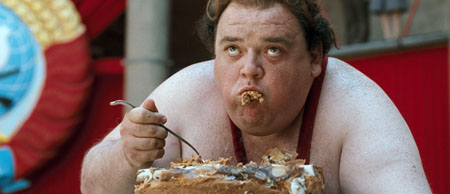
I don’t know if I would go so far as to call György Pálfi our next Fellini (circa late 1960s), our next Pasolini, or even some predictable filmmaker going out of his way to offend us — even if the visual cues for his most recent film suggests all this. But he does have talent. And Taxidermia, which finally gets a limited and long overdue American release this Friday, is certainly not for weak stomachs or limited-minded men who cloak their shallow prejudicial insights inside the sheltered caverns of higher education. The distinguished critic sitting behind me, not the type to sit through a Saw installment, made numerous sounds of disgust. I kept slouching downward in my seat so that the remnants of some half-digested lunch wouldn’t hit me unexpectedly in the back of my head. But thankfully the critic was civilized.
The New York people may not get this film. But then again, they might. For my own part, I feel inclined to applaud it. For there is a regurgitation-heavy eating contest here that makes the “Lardass” scene in Stand By Me look as innocuous as a Disney film. Two men, having just finished shoving spoonfuls of some disgusting stew in their mouth, are now regurgitating their stomachs out of view of the audience. They then begin discussing a woman they’re trying to impress in the audience, all the while puking their guts into a bucket. When they return back to the competition, Pálfi’s camera sweeps through the crowd with an unexpected excitement. I was both disgusted and galvanized by this, and it is a rare film indeed that can dislodge two entirely differing feelings like this at the same time. And this audacious emotional combo made the Hollywood movie I saw afterward seem notably limp by comparison.
But Taxidermia isn’t just a film of scatological shock value. If you’re willing to give this film a chance (and, again, I hesitate to recommend this to those of flaccid constitutions), it offers some inventive visual ideas. A joyful man pisses fire. A camera circles across a floor containing a bathtub, revealing yet another matching bathtub, which houses any number of strange sights in its cavity (an animal carcass, a recently born infant, et al.). An act of bestiality has the violated animal transforming into various women. An enormous man — that champion eater, pictured above, a few decades later — sits permanently in an apartment with endless boxes of chocolate bars. There are giant cats he keeps in a cage and that he keeps big by having his son — a taxidermist — constantly feed them butter. Should I mention the ejaculation mass that shoots into a starscape? Or the creepy pederast we discover in the landscape of a pop-up book? Or, for that matter, the cock (penis) that gets pecked by another cock (animal)?
If such sights trouble you, you should probably blame Lajos Parti Nagy, whose short stories provided the source material for Pálfi to go crazy here. And while the last ten minutes of the film does feature some minor torture porn and the results, on the whole, don’t always work, I doubt very highly that I will see another film in which two champion eaters are enlisted to eat caviar on a boat to celebrate the 20th anniversary of Communist liberation. The film can be cartoonish at times. (Gergely Trócsányi’s shouting as the champion eater grows a bit tedious, but he is replaced by another actor in the next installment. I should probably point out that this film is also a three-part multi-generational epic.) But it’s easily one of the more alive films I’ve seen in a while.
Ed, thank you for reviewing this film. It is probably one of the best films I’ve seen this year–and definitely the most daring. You may be right that New Yorkers may not get this movie–perhaps particularly its political message–but many may enjoy its visual and paradoxical emotional appeal.